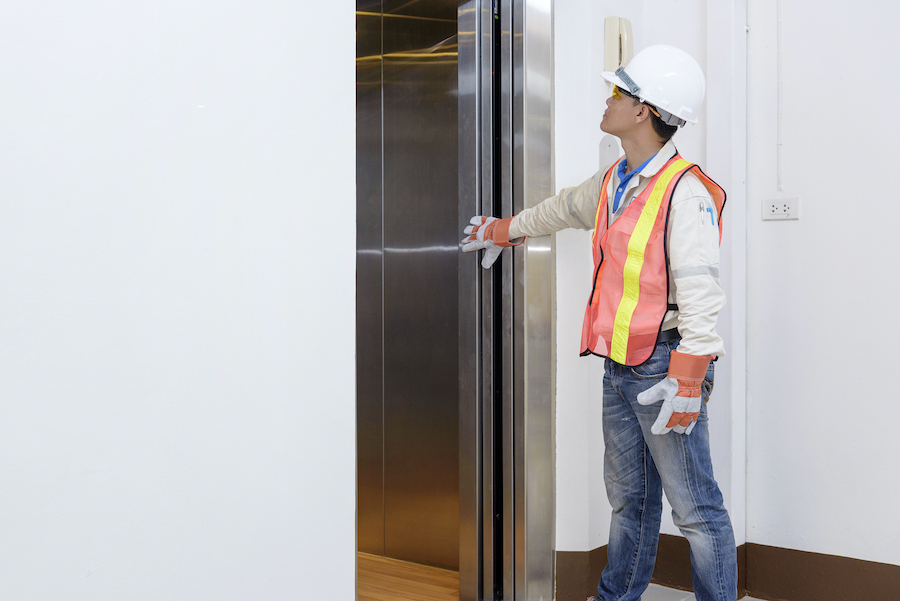BOMA hosted a webinar in mid-April on an overview of current vertical transportation compliance, plus some insight into future changes that will impact your planning, budgets, and more.
Joe Neto (Lerch Bates) and Nick Montesano (DTM) covered a comprehensive history of elevator inspections in NYC, along with the rumored possible changes. Here’s a recap of their chat:
Basic Review of Current Requirements
Current inspection requirements for vertical transportation devices have evolved pretty significantly from Local Law 10 of 1981. Today, owners are required to perform a Category 1 annual test – a visual and physical inspection to ensure code compliance. The test is performed by a licensed inspector and witnessed by a third-party witnessing agent. Owners are also required to submit Category 5 tests every 5 years, which cover every aspect of the Category 1 annual test plus a full load, full speed safety test (car & counterweight safeties, buffers, brake tests, overtravel limits, and more). These tests are also performed by your licensed elevator inspectors and witnessed by a third-party consultant.
Final reports are signed by five parties: the owner of the property, the performing agency director, the performing agency inspector, witnessing agency director, and witnessing agency inspector. Reports must be submitted in DOB NOW within 60 calendar days from the test date.
If corrections are noted as needed in the report, the elevator contractor has 120 days from the test date to make them. They then have 60 days to submit an Affirmation of Correction from the date the repairs were completed.
If everything is filed, and all corrections are made as required (and on time), your devices should be compliant for that specific calendar year (avoiding $3,000 EVCAT1, $3,000 ACC1, or $5,000 EVCAT5 penalties per noncompliant device).
Status Check – Are These New Rules In Effect Or What?
Before we get into what could change, it’s important to review the process of how regulatory changes happen.
One thing both experts stressed during the webinar is that these possible changes have been discussed internally with industry insiders – as of April 21, 2021, they’re not officially listed as a proposed rule.
What does that mean? It means there aren’t specific laid out rules for public commentary just yet. Once the proposed rules are drafted by the DOB/Elevator Division, a hearing will be scheduled to review any public comments – that’s feedback from folks in the industry (property operations teams, elevator vendors and consultants, and more).
From there, rules still have to be finalized before they’re given an effective date. Until those finalized rules are released, anything we review below isn’t set in stone.
So why are we sharing this information with you?
- It’s important to know what’s possible, especially considering these changes may impact your operating budgets and processes
- It gives you advanced time to touch base with your elevator consultants and review best practices and strategies for dealing with possible new rules
- It helps your team stay ahead of the curve and be prepared, no matter what the final rule turns out to be
With that said, keep in mind that the below possible changes are still subject to adjustment. We’ll share information about the proposed rules when they’re published so your team has an opportunity to provide comments.
Possible Change To Repair And Filing Timeframes
The DOB may be significantly adjusting the timeframes for report submissions and filings.
For example, the window for filing Cat 1 & Cat 5 test reports may be reduced from 60 days to 14 days. While this may be coupled with a reduction in who’s required to sign off on each report, it’s a significant narrowing of the filing window. Additionally, Affirmation of Correction repair and filing windows may be reduced to 30 days for most types of deficiencies.
Elevator experts are paying close attention here – we’ll keep you posted on any news.
Possible PVT Process Adjustment
In a shift that would place more responsibility on owners, the DOB may be adjusting the current PVT process.
Currently, the DOB contracts with third party inspectors to perform annual periodic inspections of devices. These are the inspections that sometimes result in PVTs.
The DOB’s current contract with these inspectors expires in June 2021. It’s believed that the contract will be extended through the end of the year. That said, it’s possible that in 2022 and beyond owners may be responsible for hiring an independent inspection agency (not your elevator contractor) to perform these annual periodic inspections. That’s separate from and in addition to Cat 1 requirements.
Obviously, this would be a marked change in scheduling and budgeting for elevator-related inspections each year. Again, it’s important to note that these are discussed possible changes – this requirement is not yet in effect.
Don’t Forget – Emergency Brake Requirements Are In Place
Unlike the above two possible changes, emergency brake requirements are in effect. That means by January 1, 2027, all traction elevators “shall be equipped with means for preventing unintended motion and ascending overspeed via a secondary or emergency brake.”
Per Joe and Nick, all traction elevators that have been installed or modernized under the A17.1 2000-2003 code should be code-compliant.
If you’re not sure, or if you know your devices aren’t compliant, connect with your elevator consultant ASAP. 2027 isn’t so far away, and planning, scheduling, and making required changes isn’t something you can do last-minute.
Our advice?
- Make sure you’re tuned into the latest industry updates via community organizations like BOMA (and the SiteCompli Blog!)
- Connect with your current elevator vendor and third party consultants to review possible changes and their impact on your buildings (DTM, Sierra Consulting Group, Lerch Bates – to name a few)
We’ll provide updates on these possible changes as soon as rules are proposed via the Department of Buildings – stay tuned!



